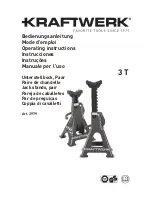
Wall Mounting Construction
19
Installation Manual
2
Concerning Installation
•
The up/down stand kit and up/down wall mount kit are for indoor use. They cannot be used outdoors.
Neither can they be installed or used in the following kinds of places.
— Places where they will be directly exposed to rain or water (including under the eaves of a house)
— Places where chemicals are used such as swimming pools
— Places with a lot of steam or grease such as manufacturing plants or kitchens, places with special
environments such as those with combustible atmospheres
— Seaborne or coastal places and places where corrosive gases are given off
— Places subject to frequent vibrations such as in vehicles or ships (the up/down wall mount kit is not
designed to be used in or on vehicles)
— Places other than walls (this is applicable to the up/down wall mount kit)
— Places where the operating temperature range of the elite Panaboard will be exceeded
•
To prevent deformation and discoloring, avoid installing the kits in places exposed to direct sunlight or
near heating or cooling appliances, etc.
•
When carrying out the work, be absolutely sure to abide by the construction-related laws and other
related ordinances of the country concerned.
3
Concerning the Installation Surface
•
Mount the up/down unit in a stable location.
The specified pull-out strength is required per anchor.
M8 anchor bolts are used when installing the up/down unit on the wall.
(Specified pull-out strength: 5,197.5 N [530 k
g
f])
•
Avoid mounting the unit on a wall, which is not a principal structure component*, with a plasterboard, plywood or other
such construction since these walls are weak. If mounting on such a wall is unavoidable, reinforce the wall adequately
(by ensuring that its ultimate strength will be at least as great as the specified pull-out strength of the anchors).
*Principal Structural Component
This term refers to walls, pillars, floors, beams, roofs and staircases, and it excludes partition walls,
stud walls, attached columns, raised floors, floors on the bottom-most levels of buildings, floors of
revolving stages, secondary beams, pent-roofs, partial sub-staircases, outdoor staircases and other
structural parts of a similar nature which are not crucial to the building from a structural point of view.
4
Concerning the Screws and Bolts Used
•
When obtaining anchors and bolts locally, be absolutely sure that they satisfy the required specifications.
•
Do not use wood screws.
5
Concerning the Tightening of the Screws and Bolts
•
Tighten the screws and bolts using the specified torque. Tightening them up using excessive torque will
damage the screw threads, causing the unit to fall off the wall. Conversely, the screws will be loose if
they are tightened up with insufficient torque.
•
The torque levels are specified, so use a torque driver to tighten up the screws and bolts.
•
The range in which the torque can be specified is limited for each torque driver. Refer to the
recommended torque levels which are specified, and use the appropriate torque driver.
•
Do not use an impact driver or power driver whose torque is difficult to control since using such a driver
may damage the screws and bolts.
•
Tighten the screws and bolts so they go straight in.
6
Other Checkpoints
•
Make sure that the location is large enough to accommodate the elite Panaboard.
Height: greater than 2,500 mm (8 ft. 2
7
/
16
in.)
Width: greater than 2,100 mm (6 ft. 10
5
/
8
in.)
•
Make sure that the AC outlet is within 3 m (9 ft. 10
1
/
8
in.) of where the system will be mounted and that
it will not be behind the up/down unit and the elite Panaboard.
•
Make sure that the Operating Instructions of the elite Panaboard to be mounted on the wall are at hand.
The Operating Instructions that are supplied with each elite Panaboard model describe how to install
each elite Panaboard directly onto the wall and how to conduct the operation checks.
UE-608030_EN.book 19 ページ 2010年10月28日 木曜日 午後4時20分
















































